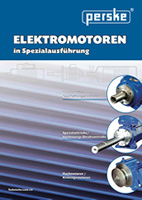Flat motors and Circular saw motors
- Perske circular saw motors have proven themselves in many years of use and under the most adverse operating conditions as being extremely reliable.
- Due to their high overload capacity and high stalling torque (approx. 2-3 times the rated torque which is significantly higher than on standard motors), our motors can also overcome the increased high demands encountered in very non-homogenous material.
- A direct drive, without a separate saw blade shaft, may be the right design for an economical, cost-effective solution (also speed-adjustable).
- Available for right- or left-hand operation, with or without brakes, and variable terminal box position.
- Special shafts with large diameters, reinforced bearings, or extreme lengths are also possible.
- Special configurations with increased water protection may be available upon request
| Rated output [kW] | [HP] | |||||
| S6-60% | Saw blade flange | Drawing | ||||
| Type | Weight | 50 Hz | 60 Hz | 60 Hz | Ø | |
| [kg] | 3,000 rpm | 3,600 rpm | 3,600 rpm | mm | ||
| KN 50.11-2 | 11.0 | 0.9 | 1.1 | 1.5 | 80 | MS 170 A177 |
| KN 51.14-2 | 12.5 | 1.3 | 1.5 | 2.0 | 80 | MS 170 A177 |
| KN 52.16-2 | 13.5 | 1.5 | 1.7 | 2.3 | 80 | MS 170 A177 |
| KN 60.09-2 | 14.5 | 2.0 | 2.4 | 3.2 | 100 | MS 3614-1 |
| KN 61.13-2 | 19.5 | 3.0 | 3.5 | 4.7 | 100 | MS 3614-1 |
| KN 62.18-2 | 22.0 | 4.0 | 4.8 | 6.5 | 100 | MS 3614-1 |
| KC 70.12-2 | 26.0 | 3.7 | 4.4 | 6.0 | 120 | MS 3862 |
| KC 71.16-2 | 33.0 | 5.0 | 6.0 | 8.0 | 120 | MS 3862 |
| KC 71.20-2 | 38.0 | 6.5 | 7.5 | 10.0 | 120 | MS 3862 |
| KC 72.28-2 | 51.0 | 9.0 | 11.0 | 15.0 | 120 | MS 3862 |
| K 81.23-2 | 69.0 | 11.0 | 13.0 | 17.0 | 160 | MS 630 A 397 |
| K 82.27-2 | 79.0 | 13.0 | 15.0 | 20.0 | 160 | MS 630 A 397 |
| K 83.37-2 | 91.0 | 18.0 | 21.0 | 28.0 | 160 | MS 630 A 397 |
| K 91.31-2 | 106.0 | 20.0 | 25.0 | 34.0 | 180 | MS 630 B 130 |
| K 93.38-2 | 128.0 | 25.0 | 30.0 | 40.0 | 180 | MS 630 B 130 |
| K 110.24-2 | 160.0 | 25.0 | 30.0 | 40.0 | 200 | MS 3954 |
| K 111.31-2 | 177.0 | 37.0 | 43.0 | 58.0 | 200 | MS 3954 |
| K 112.38-2 | 195.0 | 45.0 | 52.0 | 70.0 | 200 | MS 3954 |
| K 113.50-2 | 240.0 | 55.0 | 65.0 | 87.0 | 200 | MS 3954 |
| K 140.38-2 | 360.0 | 65.0 | 78.0 | 105.0 | 300 | MS 630 D 62 |
| K 141.50-2 | 450.0 | 75.0 | 95.0 | 128.0 | 300 | MS 630 D 62 |
| K 160.50-2 D | 625.0 | 90.0 | 110.0 | 150.0 | Upon Request | MS 3503 |
| K 162.60-2 D | 750.0 | 120.0 | 140.0 | 190.0 | Upon Request | MS 3503 |
| K 200.50-2 D | 840.0 | 140.0 | 170.0 | 230.0 | Upon Request | MS 4452 |
| K 202.60-2 D | 900.0 | 170.0 | 200.0 | 270.0 | Upon Request | MS 4452 |
Configuration for 1,500/1,800 rpm with 4-pole motor available upon request
Safety Note
If the brake motor is used as a circular saw motor, then in the event of braking, the saw blade would continue turning along with the outside flange and nut due to the rotational inertia and the nut would loosen on the thread with the corresponding results. Therefore, the nut is secured from loosening by a full-length fitted key that also applies to the external saw blade flange. The saw blade must then have a greater bore hole diameter than the shaft diameter, and rest on a spacer ring or corresponding flange bevel. It is especially pointed out that the brake is not suited to function as a holding device for tool changes (saw blade change).
